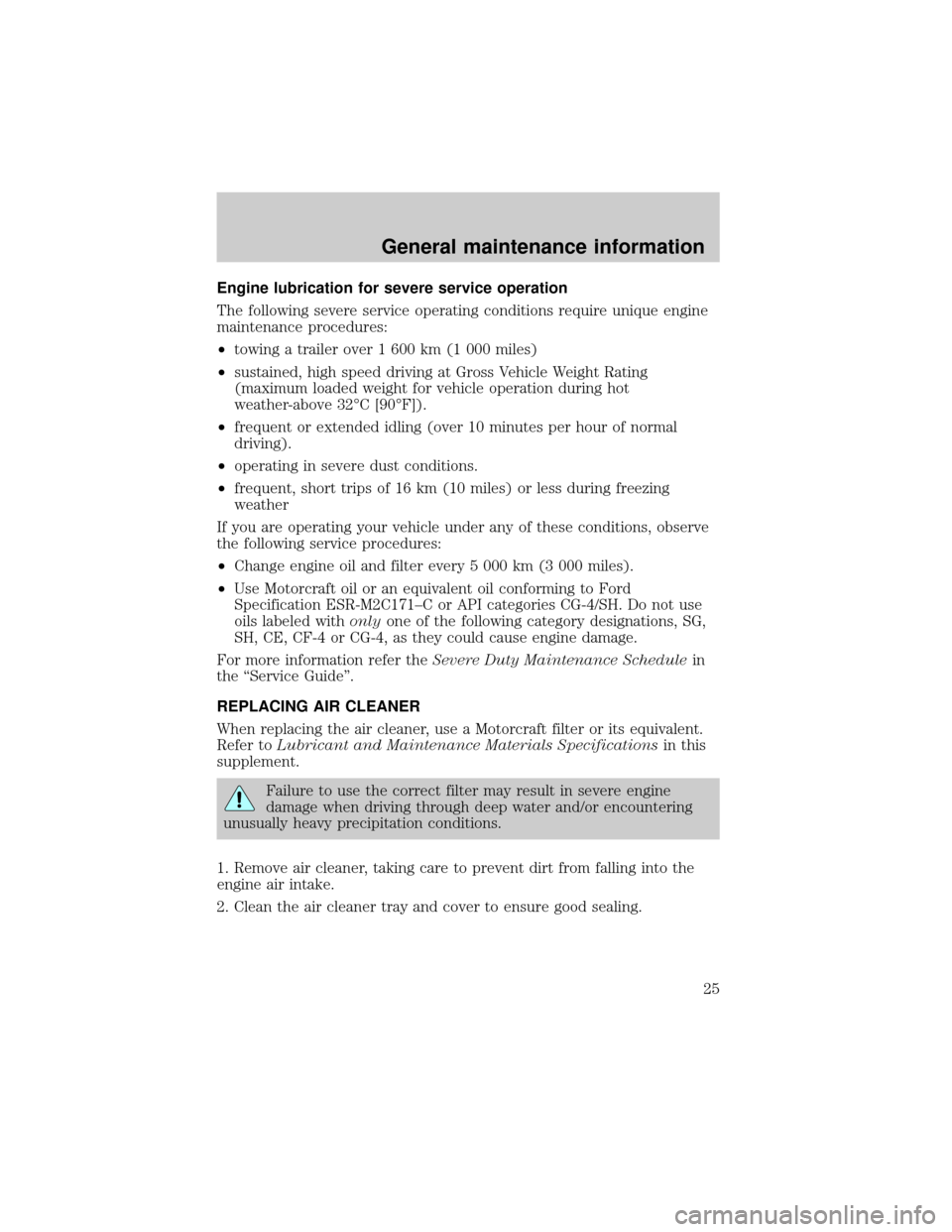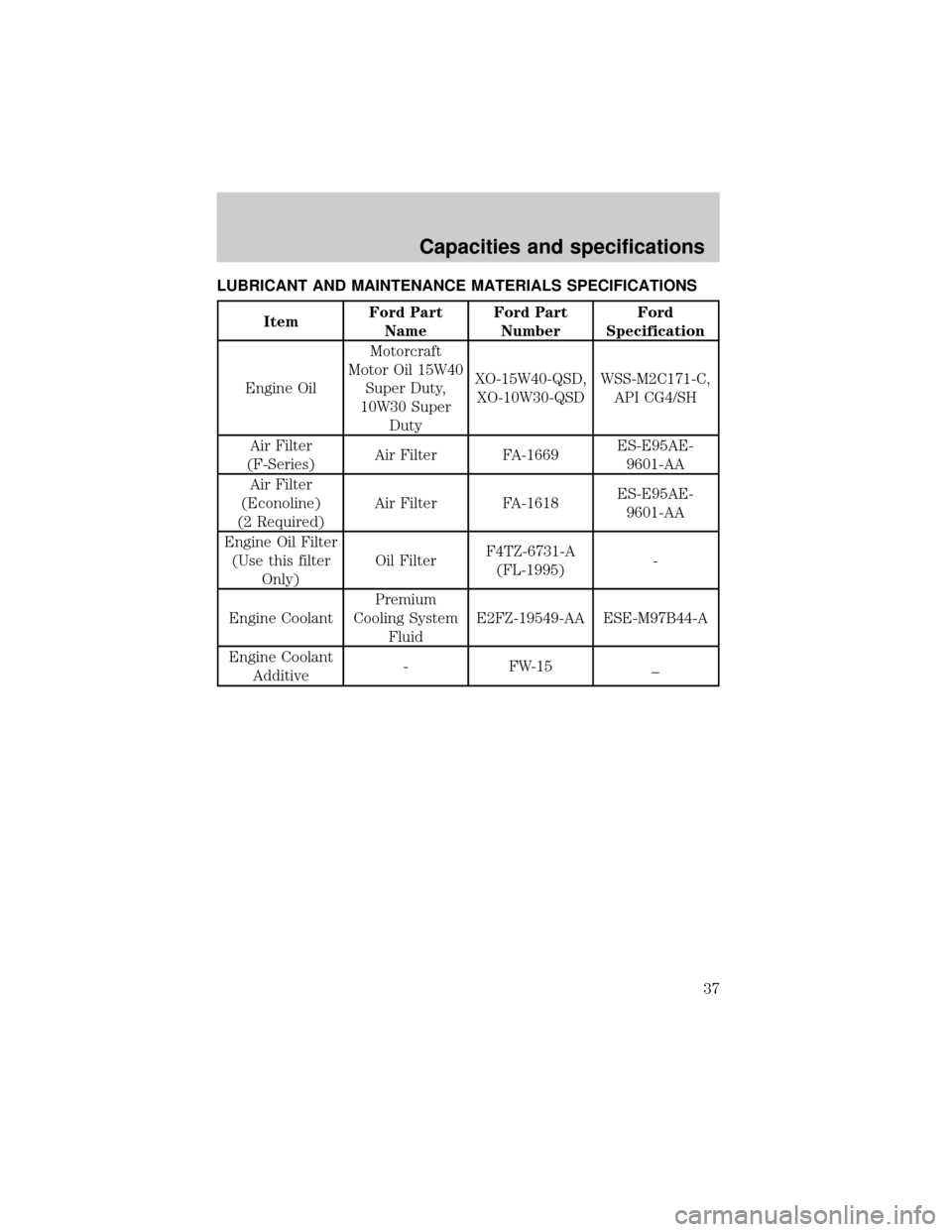1999 FORD E SERIES oil
[x] Cancel search: oilPage 23 of 39

Engine oil specifications
To help achieve proper engine performance and durability, it is important
that only engine lubricating oils of the proper quality are used in your
diesel engine and that the engine oil is changedno laterthan the
recommended interval. Diesel engines require specially formulated oil to
resist contamination. Proper quality oils also provide maximum efficiency
of the crankcase ventilating system which reduces air pollution.
For normal or severe service, use Motorcraft oil or an equivalent oil
conforming to Ford Specification WSS-M2C171±C or API Service
categories CG-4/SH. Do not use oil labeled with only one of the following
category designations; SG, SH, CE, CF-4, or CG-4, as they could cause
engine damage.
Engine oils with improved fuel economy properties (energy conserving)
are currently available. If you use an energy conserving oil, be sure it
meets the recommended Ford Specification,APIservice categories and
SAE viscosity grades listed in the Lubricant and Maintenance Materials
Specifications chart. Some energy conserving oilsdo notmeet the
requirements necessary for your diesel engine.
The use of correct oil viscosities for diesel engines is important for
satisfactory operation. Determine which oil viscosity best suits the
temperature range you expect to encounter for the next service interval.
SAE VISCOSITY GRADES
EXPECTED TEMPERATURE RANGE
F˚ -20 -10 0 10 20 30 40
40 35 30 25 20 15 10 5 0 -5 -10 -15 -20 -25 -30 C˚50 60 70 80 90 100
*15W-40 Preferred
10W-30
5W-30
0W-30Preferred
General maintenance information
23
Page 24 of 39

A symbol has been developed by the
American Petroleum Institute (API)
to help you select the proper engine
oil. It will be included on the oil
container you purchase. The top
section of the symbol shows the oil
performance by the API designation.
This should match the owner guide recommendation. The center section
will show the SAE viscosity grade. The lower section will state energy
conserving if the oil has proven fuel saving capabilities.
Changing engine oil and filter
Change your oil and filter according to the ªService Guideº. Change more
frequently if your vehicle operation includes extended periods of idling
or low-speed operation, driving for a long time in cold temperatures or
driving short distances. See the following section ªEngine Lubrication for
Severe Service Operationº for all severe duty restrictions.
Use Ford Engine Oil Filter Part No. F4TZ-6731±A (FL±1995) or
equivalent. These filters protect your engine by filtering harmful,
abrasive or sludge particles. The FL±1995 filters particles significantly
smaller than most available ªwill fitº filters.
To replace, use an oil filter wrench to unscrew the filter from the oil
cooler fitting. Turn it horizontally to let excess oil drain off, and remove.
Do not handle a hot oil filter with bare hands.
Clean the filter mounting area on the oil cooler, lightly coat the gasket
surface of the new filter with clean engine oil and hand tighten until the
gasket contacts the base.Then tighten another 1±1/4 to 2 turns.Fill
the crankcase and run the engine to check for leaks.
Continuous contact with USED motor oil has caused cancer in
laboratory mice. Protect your skin by washing with soap and
water.
APISERVICECG-4/SHSAE15W-40
General maintenance information
24
Page 25 of 39

Engine lubrication for severe service operation
The following severe service operating conditions require unique engine
maintenance procedures:
²towing a trailer over 1 600 km (1 000 miles)
²sustained, high speed driving at Gross Vehicle Weight Rating
(maximum loaded weight for vehicle operation during hot
weather-above 32ÉC [90ÉF]).
²frequent or extended idling (over 10 minutes per hour of normal
driving).
²operating in severe dust conditions.
²frequent, short trips of 16 km (10 miles) or less during freezing
weather
If you are operating your vehicle under any of these conditions, observe
the following service procedures:
²Change engine oil and filter every 5 000 km (3 000 miles).
²Use Motorcraft oil or an equivalent oil conforming to Ford
Specification ESR-M2C171±C or API categories CG-4/SH. Do not use
oils labeled withonlyone of the following category designations, SG,
SH, CE, CF-4 or CG-4, as they could cause engine damage.
For more information refer theSevere Duty Maintenance Schedulein
the ªService Guideº.
REPLACING AIR CLEANER
When replacing the air cleaner, use a Motorcraft filter or its equivalent.
Refer toLubricant and Maintenance Materials Specificationsin this
supplement.
Failure to use the correct filter may result in severe engine
damage when driving through deep water and/or encountering
unusually heavy precipitation conditions.
1. Remove air cleaner, taking care to prevent dirt from falling into the
engine air intake.
2. Clean the air cleaner tray and cover to ensure good sealing.
General maintenance information
25
Page 28 of 39

ENGINE COOLANT
Replacing coolant
A coolant mixture of 50% coolant concentrate and 50% water is
recommended to maintain best overall performance. To avoid damaging
the engine and radiator, the coolant concentrate should not exceed 60%.
When refilling the coolant system either as part of the regular
maintenance (48 months, or 80 000 km [50 000 miles], whichever comes
first and then every 36 months or 48 000 km [30 000 miles], whichever
comes first), or due to service performed, adhere to the following
instructions:
1. Drain and flush the cooling system to remove dirt deposits, oil, rust
particles.
2. Add 1.89L (4 pints) of supplemental coolant additive FW-15, directly
to the cooling system. An additional 237±295 ml (8±10 oz.) of
supplemental coolant additive FW-15 should be added at 24 000 km (15
000 mile) intervals to maintain proper concentration.
3. Fill the coolant reservoir with the specified coolant/water mixture until
the level stabilizes at the top hose fitting. Replace and tighten cap. Fill
the radiator when cold. Level the coolant in the coolant bottle.
4. Reinstall the coolant bottle cap.
5. Start and idle engine until the radiator upper hose is warm
(approximately 10±15 minutes). If the hose does not get warm then
repeat at a higher engine speed.
6. Immediately shut off engine. Cautiously remove coolant bottle cap and
add coolant to Cold Fill mark.
Checking coolant level
Check coolant level in coolant reservoir bottle at least once a month,
only when the engine is cool. Fill to within the ªCold Fill Levelº range
noted on the reservoir as required with a 50/50 mixture of coolant
concentrate and water.
A coolant mixture of 50% coolant concentrate and 50% water is
recommended to maintain best overall performance. A 60/40 antifreeze
to water ratio is acceptable for extremely cold climates, but must be
returned to a 50/50 ratio at the end of the winter season.
Vehicles with diesel engines typically are used to carry heavy loads and
accumulate mileage rapidly. These two factors cause the additives in the
General maintenance information
28
Page 32 of 39

VEHICLE EMISSIONS CONTROL INFORMATION (VECI)
Emissions information appears on
the VECI decal on the engine valve
cover. This decal identifies engine
displacement and provides certain
engine specifications.
SCHEDULED MAINTENANCE SERVICES
Refer to your ªService Guideº for details of maintenance on your vehicle.
If you are using your vehicle in a manner in which it will remain
stationary (door to door service, taxi, etc.), then it is recommended that
you change the engine oil every 200 engine hours as opposed to a
mileage limit. Since most vehicles are not equipped with hourmeters, it
may be necessary for you to approximate your time and plan engine oil
and filter changes accordingly.
Any modification of the emissions control system could create liability
under federal law (U.S.) if made prior to sale and registration, under the
laws of some states if made thereafter. Further, federal law prohibits
vehicle manufacturers, dealers and other persons engaged in the
business of repairing, servicing, selling, leasing or trading motor vehicles
as well as fleet operations from knowingly removing or rendering an
emissions control system inoperative after sale and delivery to an
ultimate purchaser. In Canada, modifications of the emissions control
system could create liability under applicable federal or provincial laws.
Scheduled maintenance
32
Page 33 of 39

The complexity of the diesel engine makes it so the owner is discouraged
from attempting to perform maintenance other than the services
described in this supplement.
If you experience difficult starting, rough idling, excessive exhaust
smoke, a decrease in engine performance or excess fuel consumption,
perform the following checks:
²a plugged air inlet system.
²water in the fuel filter/water separator.
²a clogged fuel filter.
²contaminated fuel.
²air in the fuel system, due to loose connections.
²an open or pinched sensor hose.
²low engine oil level.
If these checks do not help you correct the engine performance problem
you are experiencing, consult an authorized dealer.
FUELING
Do not use starting fluid such as ether or gasoline in the diesel
air intake system. Such fluids can cause immediate explosive
damage to the engine and possible personal injury.
If you fuel your vehicle at a truck stop, you may notice that the fuel
nozzle may shut off every 5±10 seconds. This is due to the flow rates
being designed for larger heavy duty trucks. You may have to fuel at a
slower rate (don't depress the nozzle trigger fully).
Do not run your diesel vehicle out of fuel as this will allow air to enter
the fuel system which will make restarting difficult. Longer engine
cranking time may be required once air is in the fuel system. If air enters
the fuel system (either through running the fuel tank(s) empty or during
a fuel filter change), the engine will self-purge the trapped air once it
starts running. The engine may run roughly and produce white smoke
while air is in the fuel system; this is normal and should stop after a
short time.
Minor troubleshooting guide
33
Page 36 of 39

REFILL CAPACITIES
Component Capacity
Cooling system (including heater1)-F-Series 31.0L (32.75 quarts)
Cooling system (including heater1)-Econoline228.5L (30.0 quarts)
Engine oil (including filter change)314.2 L (15.0 quarts)
Fuel tank-F- Series Refer to Owner Guide
Fuel tank-Econoline 132.5L (35.0 gallons)
Radiator cap 90 kPa (13 psi)
Manual transmission
43.2L (3.4 quarts)
Automatic transmission Refer to Owner Guide
1Includes 4.7L (5 quarts) in coolant recovery.
2Add 2.5L (2.6 quarts) if equipped with auxiliary heater option.
3Includes 1.9L (2 quarts) in engine oil filter.
4Use Motorcraft MERCONtATF, Ford part number XT-2±QDX, meeting
Ford specification MERCONt.
BULB SPECIFICATIONS
Lamp descriptionNumber of bulbs
requiredTrade number
Wait to Start Light 1 194
Water-in-Fuel Light 1 194
Engine Temp. Light 1 194
Fuel Filter 1 194
Capacities and specifications
36
Page 37 of 39

LUBRICANT AND MAINTENANCE MATERIALS SPECIFICATIONS
ItemFord Part
NameFord Part
NumberFord
Specification
Engine OilMotorcraft
Motor Oil 15W40
Super Duty,
10W30 Super
DutyXO-15W40-QSD,
XO-10W30-QSDWSS-M2C171-C,
API CG4/SH
Air Filter
(F-Series)Air Filter FA-1669ES-E95AE-
9601-AA
Air Filter
(Econoline)
(2 Required)Air Filter FA-1618ES-E95AE-
9601-AA
Engine Oil Filter
(Use this filter
Only)Oil FilterF4TZ-6731-A
(FL-1995)-
Engine CoolantPremium
Cooling System
FluidE2FZ-19549-AA ESE-M97B44-A
Engine Coolant
Additive- FW-15 _
Capacities and specifications
37